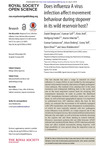Does influenza A virus infection affect movement behaviour during stopover in its wild reservoir host?
| dc.contributor.author | Bengtsson, Daniel | en_US |
| dc.contributor.author | Safi, Kamran | en_US |
| dc.contributor.author | Avril, Alexis | en_US |
| dc.date.accessioned | 2016-10-11T05:37:30Z | |
| dc.date.available | 2016-10-11T05:37:30Z | |
| dc.date.issued | 2016 | en_US |
| dc.identifier.other | HPU4160707 | en_US |
| dc.identifier.uri | https://lib.hpu.edu.vn/handle/123456789/23601 | |
| dc.description.abstract | The last decade has seen a surge in research on avian influenza A viruses (IAVs), in part fuelled by the emergence, spread and potential zoonotic importance of highly pathogenic virus subtypes. The mallard (Anas platyrhynchos) is the most numerous and widespread dabbling duck in the world, and one of the most important natural hosts for studying IAV transmission dynamics. In order to predict the likelihood of IAV transmission between individual ducks and to other hosts, as well as between geographical regions, it is important to understand how IAV infection affects the host. | en_US |
| dc.format.extent | 11 p. | en_US |
| dc.format.mimetype | application/pdf | |
| dc.language.iso | en | en_US |
| dc.subject | Biology | en_US |
| dc.subject | Behaviour | en_US |
| dc.subject | Health and disease and epidemiology | en_US |
| dc.subject | Ecology | en_US |
| dc.subject | Avian influenza A virus | en_US |
| dc.subject | Effect of infection | en_US |
| dc.subject | Mallard | en_US |
| dc.subject | Movement | en_US |
| dc.subject | Stopover | en_US |
| dc.subject | Transmission | en_US |
| dc.title | Does influenza A virus infection affect movement behaviour during stopover in its wild reservoir host? | en_US |
| dc.type | Article | en_US |
| dc.size | 648KB | en_US |
| dc.department | Education | en_US |
Files in this item
This item appears in the following Collection(s)
-
Education [806]

